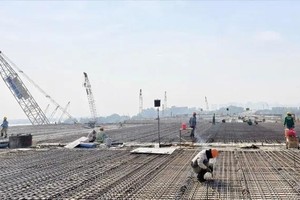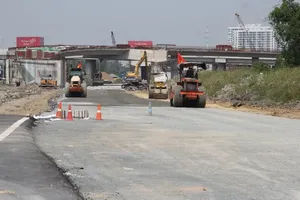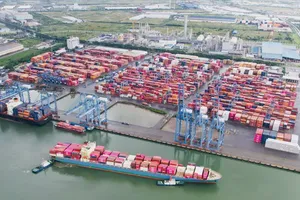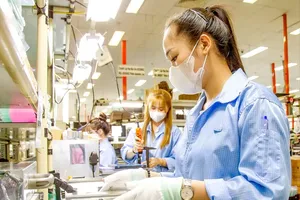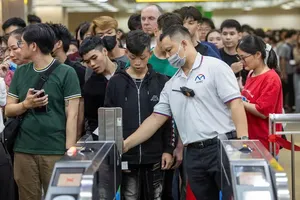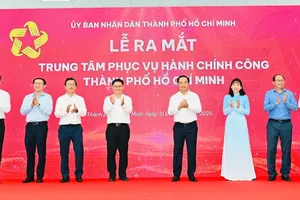
According to a report by the Ho Chi Minh City People's Committee, the current wastewater treatment rate of the city is nearly 13 percent. The city currently has three wastewater treatment plants including Binh Hung plant (phase 1) with a treatment capacity of 141,000 cubic meters a day; Binh Hung Hoa plant with a capacity of 30,000 cubic meters per day; Tham Luong - Ben Cat plant (phase 1) with a capacity of 15,000 cubic meters per day.
The city also has four wastewater treatment plants in residential and resettlement areas such as Tan Quy Dong in District 7 with a capacity of 500 cubic meters per day; Vinh Loc B in Binh Chanh District with a capacity of 3,700 cubic meters per day; a 17.3ha resettlement area with a capacity of 3,000 cubic meters per day; a 38.4ha resettlement area in Thu Duc City’s Binh Khanh Ward with a capacity of 150 cubic meters per day.
Intending to reach a wastewater treatment rate of 40.2 percent by 2025, the city is also promoting the call for investment in seven projects with a total capital of about VND 31,740 billion (US$1,249,326,027).
Besides, Deputy Director Huynh Van Thanh of the Department of Natural Resources and Environment of Ho Chi Minh City, informed that to call for investment in household solid waste treatment in the form of PPP, the city has assigned the Mechanical and Electrical Joint Stock Company to prepare a pre-feasibility study report for building a solid waste treatment and energy recovery plant at the Northwest Solid Waste Treatment Complex in Cu Chi outlying district.
The Department of Planning and Investment is carrying out procedures to appraise the pre-feasibility study report of the project. After the project’s investment policy and the feasibility study report are approved, the city will organize a wide tender to select appropriate investors.
According to the Vietnam International Arbitration Center, the amount of urban domestic wastewater generated is currently about 3,650 million cubic meters a day, but the collection and treatment rate according to standards is only about 13 percent to 17 percent. Vietnam also has a blueprint for an increase in the wastewater treatment rate to 70 percent within the next 10 years. However, to realize this goal, the city needs US$10-20 billion.
Statistically, the country currently generates about 60,000 tons of domestic solid waste per day, and the whole country currently has 1,322 domestic solid waste treatment facilities, including 381 solid waste incinerators, 37 compost processing lines, and 904 landfills. Currently, there are no accurate statistics on the amount of capital needed to invest in the treatment of the daily generated domestic solid waste, but as per responsible agencies’ estimate, the city needs a huge capital for this problem.
A representative of the Ministry of Natural Resources and Environment said that although the demand for capital for wastewater and waste treatment is quite huge, participants in projects have to rely on ODA capital and the state budget, but due to their limited financial resources, they still fail to meet the demand. Meanwhile, the city is bumping into difficulties in calling for investment in the form of PPP in the two fields.
Specifically, because the infrastructure has not yet met the actual situation; the price of wastewater and waste treatment services is still low whereas the costs of operating and maintenance costs of the treatment system are high. Besides, the mechanism to mobilize private capital has not yet been effective, there is a lack of specific commitments and support to create a favorable, open and safe investment environment for investors.
Chairman Vu Tien Loc of the Vietnam International Arbitration Center commented that the Law on investment in the form of public-private partnership (PPP Law) has been issued by the National Assembly. It has been in effect since 2021 with the expectation of making progress in attracting investment from the private sector through PPP cooperation to implement infrastructure projects for socio-economic development.
In an interview with a reporter from SGGP Newspaper, lecturer Huynh Thanh Dien from Nguyen Tat Thanh University assessed that the demand for infrastructure investment in Vietnam is extremely huge while the capital is extremely limited. In addition, the capital disbursement process in Vietnam is also very complicated which will slow down projects. At this time, the PPP partnership method is needed to solve the capital problem for infrastructure investment.
Currently, PPP cooperation in Vietnam is only focused on the transport sector, but this method is considered to be quite suitable for the fields of environment, health, and education.
The potential for PPP partnership development in Vietnam is still high, requiring good solutions for related issues such as transparency of projects, clear legal framework, selection of suitable investors and clear and transparent mechanisms, said lecturer Huynh Thanh Dien.




